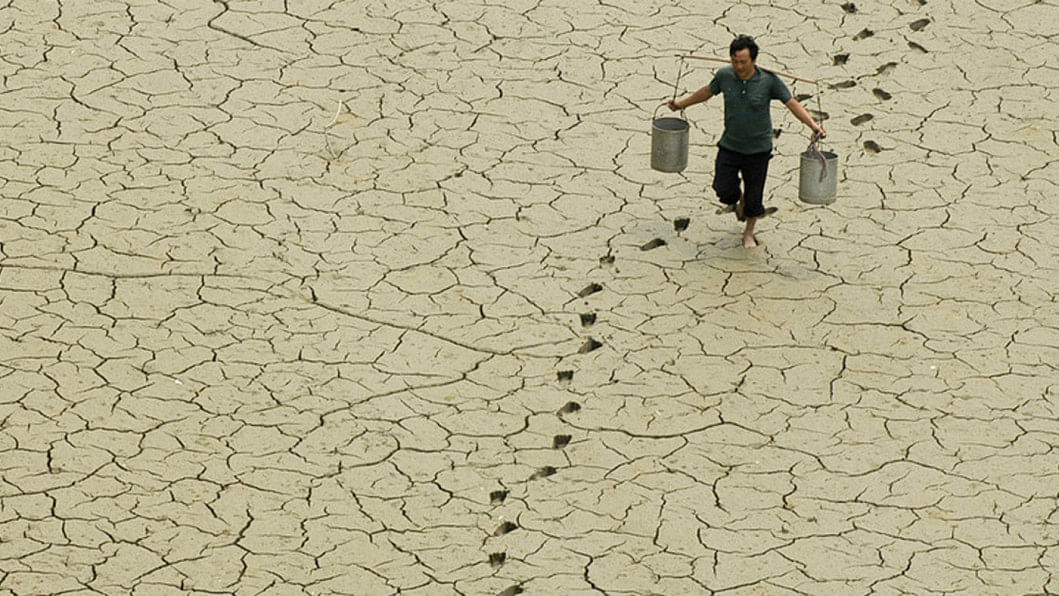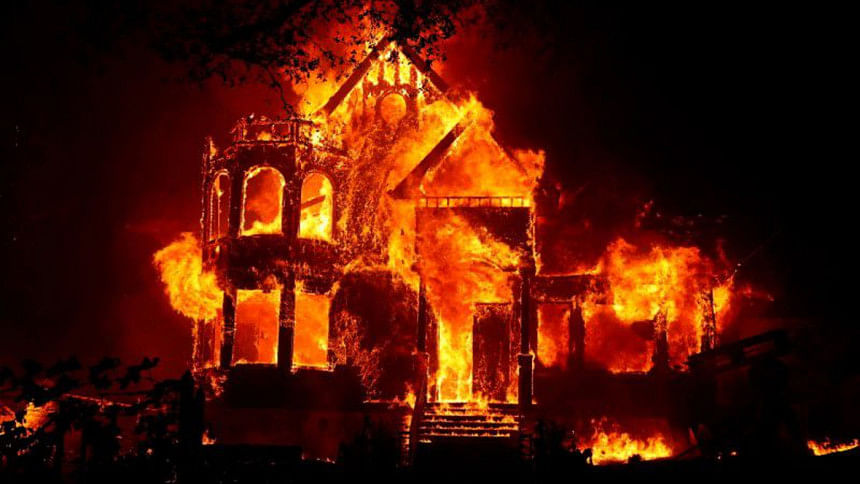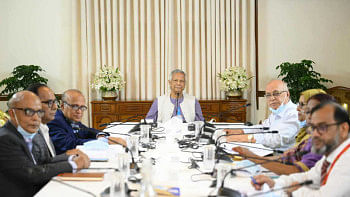IPCC issued a ‘code red’ alert, but is anyone listening?

As the world battles record-shattering heat waves, calamitous droughts, deadly floods and landscape-altering wildfires, a roughly 4,000-page report released on August 9, 2021 by the UN's Intergovernmental Panel on Climate Change (IPCC) spells out, in unequivocal terms, how anthropogenic climate change is ravaging our planet. Prepared by IPCC's Working Group I and described by its authors as a "code red for humanity," the report warns that global temperatures will likely rise by 1.5 degrees Celsius by 2040 if warming continues at the current rate. This is the threshold value agreed upon in 2015 at the 21st Conference of Parties (COP21) in Paris.
Key takeaways from the IPCC report |
| > Climate change is a reality and it is going to get worse |
| > Humans are responsible for the "widespread, rapid and intensifying" effects of climate change, and some of them are irreversible |
| > Extreme weather is on the rise and will keep getting worse |
| > Oceans have warmed, their acidification has increased, and there has been a drop in Arctic sea ice |
| > Glaciers are melting at an accelerated pace |
| > Sea-level rise will be worse than once thought |
| > We must cut greenhouse gas emissions now, before brutal weather becomes more prevalent and more destructive |
| > Tipping points, or cut-offs—which, when exceeded, will set off self-perpetuating irreversible loops in the natural world—have a "low likelihood," but they cannot be completely ruled out |
After the report was made public, UN Secretary-General António Guterres said, "The alarm bells are deafening, and the evidence is irrefutable: greenhouse gas emissions from fossil fuel burning and deforestation are choking our planet and putting billions of people at immediate risk." Many media outlets did not mince words to describe the nightmarish scenario painted in the report about the future of our planet. The front page headline in The New York Times read, "A Hotter Future Is Certain, Climate Panel Warns. But How Hot Is Up to Us." The Atlantic described the crisis with two words: "It's Grim." One of the authors of IPCC's 2001 report told CNN, "Bottom line is that we have zero years left to avoid dangerous climate change, because it's here." On the other hand, in an opinion piece in the conservative The Wall Street Journal, a physicist expressed skepticism about coverage by the media. He wrote, "Despite constant warnings of catastrophe, things aren't anywhere near as dire as the media say."
Awareness about climate change is not new
Eight years in the making, the report essentially validates the seemingly bleak future that many of us foresaw with trepidation. It also confirms what scientists had predicted even before coal-fired power plants were built. In 1856, American scientist Eunice Foote was the first to describe the extraordinary power of carbon dioxide—the driving force of global warming—to absorb heat. The first quantitative estimate of climate change influenced by carbon dioxide was made in 1895 by Svante Arrhenius, a Swedish scientist and Nobel laureate.
For the general public, physicist James Hansen of NASA sounded the alarm about climate change after his testimony to the US Congress in June 1988 on the detrimental effects of human-induced greenhouse gas emissions. Yet in 1995, the IPCC is on record stating that the ability to connect climate change to human activities is "currently limited." This time around, the IPCC admits that they can now link recent natural disasters with climate change in a way that they have not been able to before. What an about-turn!
The latest IPCC report is a stark reminder of what we are experiencing today—scorching summers roasting millions of people worldwide, out-of-control wildfires, protracted droughts, widespread famine, killer storms, torrential rainfall followed by cataclysmic floods, and more. These are among the most visible and damaging signs that the Earth's climate is changing for the worse as a result of burning fossil fuels. And all these weather-related events are happening because the world warmed by a "mere" 1.1 degrees Celsius since the Industrial Revolution. Clearly, with each passing day, these events will become more intense, turbocharged, amplified, and worse.
Thanks to the report, many Republicans in the US Congress, who for decades disputed the existence of climate change, no longer deny that the Earth is heating up because of greenhouse gas emissions. Or perhaps the statement from the US National Oceanic and Atmospheric Administration—that July was the world's hottest month ever recorded—forced them to acknowledge climate change. However, they are still unwilling to abandon fossil fuels.

Current emissions and the future of our planet
Since the 1980s, emissions, particularly of carbon dioxide, have ballooned to unprecedented levels despite repeated, and at times frantic, warnings from scientists about "civilisation-shaking" catastrophes. Scientists at the International Energy Agency say that emissions of carbon dioxide "are on course to surge by 1.5 billion tonnes in 2021, the second-largest increase in history, reversing most of last year's decline caused by the Covid-19 pandemic."
Climate is controlled by how much of the Sun's heat arrives at and remains trapped near the Earth's surface. Because the Sun is expected to shine at the minimum for another five billion years, we can envisage no major changes in the incoming heat for many thousands of years to come. Thus the changes we will see in climate from now until 2050, a cut-off year determined at COP21 to reduce greenhouse gas emissions to zero, will mostly depend on how much of the arriving heat is retained by the Earth's surface.
Having said that, even if the goals of COP21 are met, the Earth will still be warmer in the future than it is today and the warming trend will continue because it takes a long time for the Earth's climate to adjust to the changes in its energy budget, resulting from increased greenhouse gas concentrations. Besides, if emissions of carbon dioxide dropped to zero tomorrow, climate change will continue to play out for centuries because the greenhouse gases already in the atmosphere have lifetimes of hundreds and thousands of years. Given this circumstance, we can still keep warming below catastrophic levels by going carbon negative together with zero emission. Carbon negative means removing more carbon dioxide from the atmosphere than adding to it.
Climate change and Bangladesh
As for Bangladesh, it is among the countries most vulnerable to the effects of climate change. Although the global share of carbon dioxide emissions by Bangladesh is a meagre 0.21 percent, climate change has already been inflicting untold miseries on its people. The government has identified floods, cyclones, droughts, tidal surges, tornadoes, river erosion, water logging, rising sea level and soil salinity as major hazards that are behind a shift in migration and increasing poverty.
Bangladesh has a hot climate, with summer temperatures that can hit 45 degrees Celsius. In a world that is hotter by 1.5 to two degrees Celsius, heat waves will break new records, with more than half of summers being abnormally hot. Northern Bangladesh will enter a new climatic regime, with temperatures above levels not seen in the past 100 years. In light of this fact, the government is rightfully demanding that industrialised nations, who are also the biggest emitters of greenhouse gases, reduce their planet-warming pollution without further delay, compensate poor countries for the damages caused, and fund them so that they can be better prepared for a perilous future.
In the past few years, the Bangladesh government made significant advances in disaster risk reduction. It has constructed a series of multi-purpose buildings that are used as storm shelters during cyclones, significantly reducing mortality. Notwithstanding, the damage and loss of income due to climate change is on the rise. Nevertheless, if Bangladesh wants to become a middle-income country, the government should focus on mitigation along with adaptation, and move away from coal-fired power plants.
On a different note, the amount of methane emitted by Bangladesh is so high that the country is now becoming a significant contributor to environmental degradation. Methane is a greenhouse gas that can cause 28 times as much warming as an equivalent amount of carbon dioxide over a period of 100 years. According to IPCC, the concentration of methane in the atmosphere is higher now than at any time in the last 800,000 years.
Melting of glaciers and ice sheets
A few words about the effects of global warming on one of the primary sources of fresh water are in order here. Out of the 71 percent of water that make up the Earth's surface, the vast majority, over 96 percent, is non-drinkable saline water in seas and oceans. Just 3.5 percent is fresh water, but a minuscule amount—approximately one percent—are in freshwater lakes, streams and in the atmosphere. The bulk of the fresh water, almost 70 percent, is trapped in ice and glaciers. While most of the ice is in the Arctic, Antarctic and Greenland, some are scattered as glaciers in the mountains around the world.
The glaciers we see today are remnants of the past Ice Age, an alternating period of melting and freezing that lasted about a million years. Yielding only to the warmth of the Sun's rays, these giant rivers of ice grind their way to the sea, crushing everything in their path, scouring the landscape, shaping mountain peaks and carving broad valleys.
Considered to be the "gold standard for measuring climate change," glaciers are a natural data bank. In between their thick layers of compacted snow, glaciers hold records of volcanic eruptions, chemicals in the air and changes in the atmosphere. They reflect variations in the pattern of weather and climate over long periods of time.
Glaciers feed many of the world's important river systems, including the Brahmaputra, Ganges and Indus, and directly or indirectly supply millions of people with food, energy, clean air and incomes. Communities living at the foothills of large mountains use glaciers as a source of water.
Across the high mountain region from the Hindu Kush to the Himalayas, which stretches from Afghanistan in the west to Myanmar in the east, air temperatures have risen by nearly two degrees since the start of the 20th century. In response, glaciers are melting and retreating, permafrost is thawing and weather patterns are becoming more erratic, disrupting previously reliable water sources for millions and triggering more natural disasters. Scientists are worried that the impacts will hit not just those living in the mountains, but also millions of people in Bangladesh, India and Pakistan living in the river valleys below.
Melting of glaciers has another effect. More melting means more water pools in lakes on top of the glaciers or at their lower snouts. Since the late 1970s, the number of glacial lakes across the Himalayas in Nepal has more than doubled. These lakes are often growing so fast and hold so much water that they have gushed through the rock piles holding them back, resulting in devastating floods. Additionally, steep slopes that were locked in place by frozen soil have thawed, causing rockfalls, collapsing terrains, avalanches and mud slides.
Because of global warming, ice sheets are melting at breakneck speed and will continue to melt. Indeed, a historic heat wave in July melted ice in Greenland large enough to flood the entire state of Florida with well-nigh two inches of water. At the same time, extreme flooding from higher sea level will continue to get more frequent, and the sea level itself will continue to rise well into the next century, mainly because of thermal expansion due to the amount of heat the oceans have absorbed so far.
Widespread loss of ice sheets will likely alter climate in other complex ways. For example, their white surfaces help to keep our climate relatively mild by reflecting the Sun's rays. When they melt, darker exposed surfaces will absorb and retain more heat, thereby raising global temperatures.
Are we doing enough?
It is now a truism that global warming begets more warming. Therefore, the effects of climate change will worsen with every fraction of a degree of warming. Even if we limit warming to 1.5 degrees, the kinds of extreme weather events we are experiencing this year, in winter and summer alike, will become more severe and more recurrent. Beyond 1.5 degrees, scientists say the climate system will be unrecognisable. In all likelihood, it will lead to the disappearance of small island nations and low-lying coastal countries, as well as unleash tens of millions of climate refugees upon an unprepared world.
What will be the response of our leaders and policymakers after they read the IPCC report? It will not be an exaggeration to say that world leaders, who are under tremendous pressure to deliver on promises made at COP21, cannot distinguish the divide between rhetoric and reality. Hence, at COP26, to be held in Glasgow, Scotland later this year, we should not expect any firm commitment from them to save the world. Instead, their speeches will be like the ones given at past climate-related summits—"full of sound and fury, signifying nothing."
Finally, the well-researched and well-intentioned report on climate change and recommendations for mitigation and adaptation contained therein can, metaphorically speaking, be characterised as a "recovery mission" rather than a "rescue mission."
Quamrul Haider is a Professor of Physics at Fordham University, New York.

 For all latest news, follow The Daily Star's Google News channel.
For all latest news, follow The Daily Star's Google News channel. 



Comments